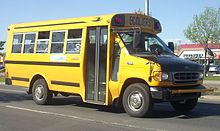
The Blue Bird Corporation is an American bus manufacturer headquartered in Fort Valley, Georgia. Best known for its production of school buses, the company has also manufactured a wide variety of other bus types, including transit buses, motorhomes, and specialty vehicles such as mobile libraries and mobile police command centers. Currently, Blue Bird concentrates its product lineup on school buses, school pupil activity buses, and specialty vehicle derivatives.

A school bus is any type of bus owned, leased, contracted to, or operated by a school or school district. It is regularly used to transport students to and from school or school-related activities, but not including a charter bus or transit bus. Various configurations of school buses are used worldwide; the most iconic examples are the yellow school buses of the United States which are also found in other parts of the world.
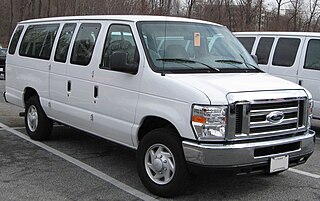
The Ford E-Series is a range of full-size vans manufactured and marketed by the Ford Motor Company. Introduced for 1961 as the replacement of the Ford F-Series panel van, four generations of the model line have been produced. Marketed for both cargo and passenger transport configurations, the E-Series has been designed with multiple design variations for both retail and commercial sale, including vans, and commercial-grade cutaway van chassis and stripped chassis.

The Chevrolet Express is a series of full-size vans produced by General Motors since 1996. The successor to the Chevrolet G-series van, the Express is produced in passenger and cargo variants. Alongside the standard van body, the line is offered as a cutaway van chassis, which is a chassis cab variant developed for commercial-grade applications, including ambulances, buses, motorhomes, and small trucks.

The Ford Aerostar is a range of vans that was manufactured by Ford from the 1986 to the 1997 model years. The first minivan produced by Ford, the model line was marketed against the Chevrolet Astro/GMC Safari and the first two generations of the Chrysler minivans. Introduced shortly before the Ford Taurus, the Aerostar derived its name from its slope-nosed "one-box" exterior.
The Wayne Corporation was an American manufacturer of buses and other vehicles under the "Wayne" marque. The corporate headquarters were in Richmond, Indiana, in Wayne County, Indiana. During the middle 20th century, Wayne served as a leading producer of school buses in North America.
Girardin Minibus Inc. is a Canadian bus manufacturer. Based in Drummondville, Quebec, Canada, Girardin forms part of the Micro Bird joint venture with Blue Bird Corporation. As part of Micro Bird, Girardin is a manufacturer of bus bodies for minibuses for cutaway van chassis.
Corbeil is a defunct trade name that has been used in bus manufacturing. From 1936 to 1975, J.H. Corbeil was a manufacturer of bus bodies; Les Enterprises Michel Corbeil was a body manufacturer that specialized primarily in school buses, opened from 1985 to 2007. In 2007, the company was acquired out of bankruptcy by Collins Industries and renamed Corbeil Bus Corporation. Serving as the Canadian equivalent of Collins Bus Corporation, manufacturing was shifted from Quebec to Hutchinson, Kansas.

The Wayne Busette is a minibus that was assembled by Wayne Corporation. The Busette was first introduced as a compact school bus in 1974. The school bus body was designed to fit on a Chevrolet, Ford, or GMC chassis.

Cutaway van chassis are used by second stage manufacturers for a wide range of completed motor vehicles. Especially popular in the United States, they are usually based upon incomplete vans made by manufacturers such as Chrysler, Ford, and General Motors which are generally equipped with heavier duty components than most of their complete products. To these incomplete vehicles, a second stage manufacturer adds specific equipment and completes the vehicle. Common applications of this type of vehicle design and manufacturing includes small trucks, school buses, recreational vehicles, minibuses, and ambulances. The term "cutaway" can be somewhat of a misnomer in most of the vehicle's context since it refers to truck bodies for heavy-duty commercial-grade applications sharing a common truck chassis.
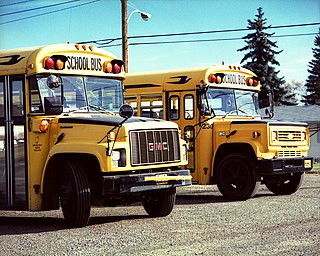
The Chevrolet and GMC B series was a series of cowled chassis that were produced by General Motors. Produced across three generations from 1966 to 2003, the model line was a variant of medium-duty trucks marketed under the Chevrolet and GMC nameplates. Initially derived from the medium-duty C/K series, later examples were derived from the GMT530 architecture.

Chevrolet Nomad is a nameplate used by Chevrolet in North America from the 1950s to the 1970s, applied largely to station wagons. Three different Nomads were produced as a distinct model line, with Chevrolet subsequently using the name as a trim package.

The Chevrolet Kodiak and GMC TopKick are a range of medium-duty trucks that were produced by the Chevrolet and GMC divisions of General Motors from 1980 to 2009. Introduced as a variant of the medium-duty C/K truck line, three generations were produced. Slotted between the C/K trucks and the GMC Brigadier Class 8 conventional, the Kodiak/TopKick were developed as a basis for vocationally oriented trucks, including cargo haulers, dump trucks, and similar vehicles; on later generations, both cutaway and cowled-chassis variants were produced for bus use.
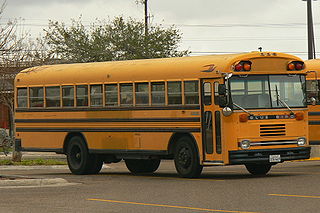
The Blue Bird TC/2000 is a product line of buses that was produced by the American manufacturer Blue Bird Corporation from 1987 to 2003. Introduced as a second transit-style product range alongside the Blue Bird All American, the TC/2000 was produced in front-engine and rear-engine layouts. While produced primarily as a yellow school bus, Blue Bird offered the TC/2000 in commercial configurations and numerous custom-built variants. For commercial use, Blue Bird badged the model line as the TC/2000 or the APC 2000.
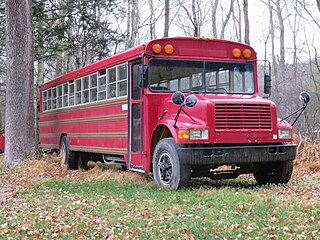
The bus chassis variant of the International S series is a cowled bus chassis that was produced by International Harvester from 1979 to 2004. Produced primarily for school bus applications, the chassis was also produced for other applications, including commercial-use buses and cutaway-cab buses. In addition, the cowled chassis formed the basis for front-engine and rear-engine stripped chassis produced for bus applications.

The Blue Bird All American is a series of buses produced by American school bus manufacturer Blue Bird Corporation since 1948. Originally developed as a yellow school bus, versions of the All American have been designed for a wide variety of applications, ranging from the Blue Bird Wanderlodge luxury motorhome to buses for law enforcement use.

The ThomasMinotour is a bus body manufactured by Thomas Built Buses since 1980. The smallest vehicle sold by the company, the Minotour is a bus body designed for cutaway van chassis. Primarily sold for school bus usage, the Minotour is also produced as a MFSAB or in specialized configurations specified by the customer.

The Chevrolet Van or Chevy Van is a range of vans that was manufactured by General Motors from the 1964 to 1996 model years. Introduced as the successor for the rear-engine Corvair Corvan/Greenbrier, the model line also replaced the panel van configuration of the Chevrolet Suburban. The vehicle was sold both in passenger van and cargo van configurations as well as a cutaway van chassis that served as the basis for a variety of custom applications.

The third generation of theC/K series is a range of trucks that was manufactured by General Motors from the 1973 to 1991 model years. Serving as the replacement for the "Action Line" C/K trucks, GM designated the generation under "Rounded Line" moniker. Again offered as a two-door pickup truck and chassis cab, the Rounded Line trucks marked the introduction of a four-door cab configuration.


